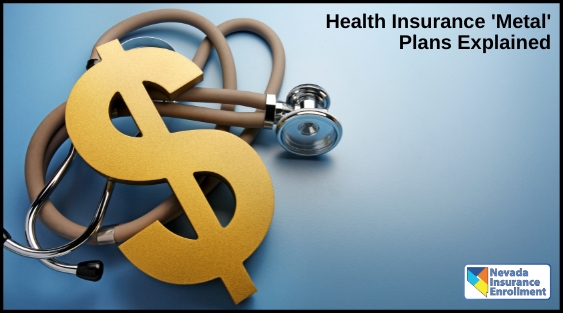What Is the Difference Between the Metal Plans?
PLATINUM | GOLD | SILVER | BRONZE
From 1/1/2014 on, all individual and family health insurance plans will have these “Metallic” names whether you purchase health insurance “On Exchange” or “Off Exchange”. It gives you an easy-to-understand overview of how the plans will share the payment of your medical bills.
Health insurance companies that sell plans on the Health Insurance Marketplace can offer four types of qualified health insurance plans, including Bronze, Silver, Gold, and Platinum. The plan you choose determines not only the premium you pay but also what portion of your health costs you pay.

To make it easier to shop for coverage, health insurance plans have standardized “metals”. The “metal” plan depends on its actuarial value, or the average percentage of health care costs the plan pays vs what the member pays. The more coverage a plan provides, the higher the monthly premium and the fancier the metal level. Gold is better than Silver. Silver is better than Bronze.
-
Platinum plans cover 90% of medical expenses
-
Gold plans cover 80% of medical expenses
-
Silver plans cover 70% of medical expenses
-
Bronze plans cover 60% of medical expenses
This percentage will not go on forever, there is always an “Out of Pocket Maximum” (this is your pocket, not the insurance company), so you’ll only pay your portion of the expenses until you’ve reached your out-of-pocket maximum.

The Out-of-Pocket Maximums for 2023 are:
Individuals: $9,100 Families: $17,400
You’ll want to review your “Summary of Benefits and Coverage” to find out what your deductible is, your co-insurance, your out-of-pocket maximum, along with all of the important details of what your plan covers.
What Do the Health Insurance Plans Cover?
Regardless of the plan you choose, it will provide all 10 essential health care benefits guaranteed to policyholders under the Affordable Care Act. The difference among the plans has to do with how much overall out-of-pocket costs you’ll pay up to your out-of-pocket maximum.
Choose the Right Health Plan with Nevada Insurance Enrollment
Choosing the right metal tier requires evaluating your budget and assessing current and expected health care needs. Our agents guide you in reviewing the options available across the tiers and help you determine which plan best fits your health needs and budget. We can also help you determine whether you qualify for subsidies to lower your premium.
Recent Posts

Are You a High-Risk Driver? What is Your Auto Insurance Score?
A high-risk driver is one who is more likely to file a claim. To determine your riskiness, your auto insurance company uses a complex algorithm that weighs in a variety of factors to come up with your auto insurance score.




Original Equipment Manufacturer (OEM) vs Aftermarket Parts
Do you have car damage that needs to be repaired or parts that need to be replaced? You may assume that the repairs will be done using OEM parts, which means “Original Equipment Manufacturer”, but this isn’t always the case so make sure to review the coverages you have in your auto insurance policy.




What is Gap Insurance?
Gap insurance is optional auto insurance coverage that covers the difference between the actual cash value (ACV) and the amount owed on the loan of your car if your car is totaled or stolen. Standard auto insurance covers the current depreciated value of your car.
Search This Website
Most Popular Pages
By page visits (this month)
#1) Health Insurance Subsidy Chart
#2) Health Insurance
#3) Health Insurance WITH a Subsidy
#4) Insurance Blog
#5) Request a Quote
Top 5 Most Popular
By page visits (this month)
#1) Health Insurance Subsidy Chart
#2) Health Insurance
#3) Health Insurance WITH a Subsidy
#4) Insurance Blog Posts
#5) Request a Quote
Recent Posts
Term Life Insurance vs. Whole Life Insurance
Term life insurance policies will often have terms of one year to 30 years. Typically, the monthly premium (monthly payment) stays the same throughout the term of the policy. Whole life insurance provides coverage your whole life and it includes something called “cash value”. Think of it like a mini savings account attached to the policy.
Rental Reimbursement vs. K4 or K5 Coverage
Rental reimbursement would reimburse you for either your daily rental charges or your policy limit, whichever is less. It can be used after any covered collision or comprehensive loss (assuming you carry collision and comprehensive coverage). K4 and K5 coverage can also help with post-accident “loss-of-use” costs.
Insuring and Preparing a Teenage Driver
Statistically speaking, young drivers are the riskiest group on the road. Studies have shown that they’re more likely to exhibit dangerous behavior like speeding or texting while behind the wheel.
How Does My Auto Insurance Company Make Its Profit?
Have you ever wondered how an auto insurance company stays in business? They make money because they sell a product that people are legally required to purchase. The average person pays around $900 a year for auto insurance but it’s nothing compared to how much a single car accident can cost.